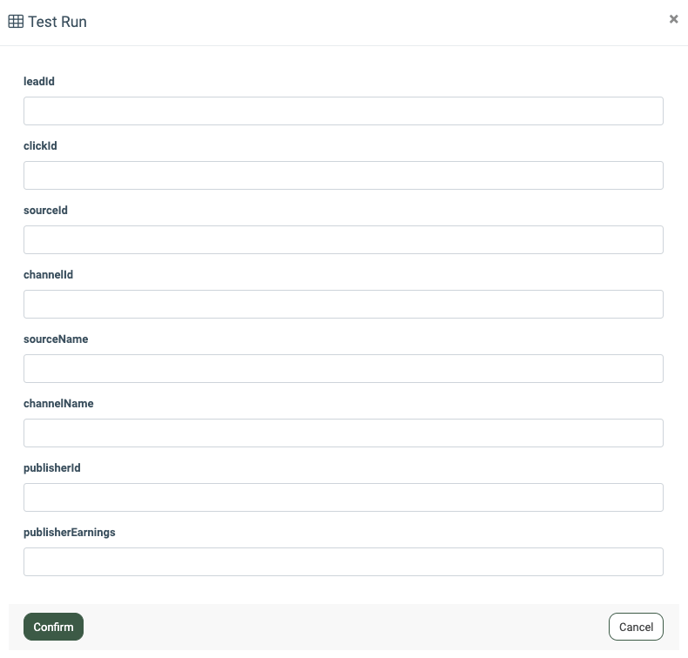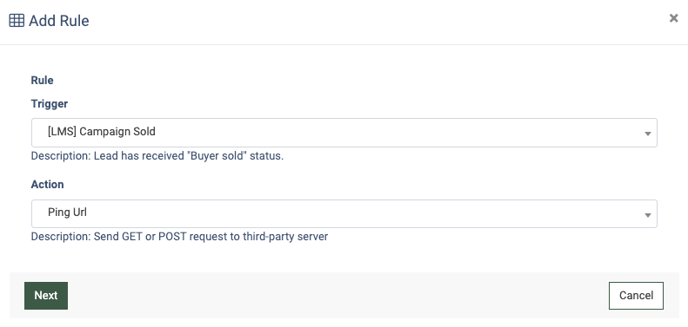Check our short guide to Campaign Configuration: Tracking and learn how to add a new tracking URL and manage the inbound tracking feature.
The Tracking tab allows you to configure the Event Tracking and Inbound Tracking features for the selected Campaign.
To access the tab, go to the Client Management > Setup > Campaigns section, select the Campaign from the list and click the “Configure” button in the “Actions” column. On the Campaign Setup page, select the “Tracking” tab.

Event Tracking
The “Tracking” block allows you to set up the Event Tracking rules. The Event Tracking feature allows you to track the various events in the system(e.g., lead sold, lead rejected, etc.) and set the actions to be automatically triggered by them. Read more about Event Tracking in this article.
The list of Event Tracking Rules contains the following information:
- ID: The unique identification number of the rule.
- Trigger: The name of the trigger that is set in this rule.
- Trigger Settings: The list of settings for the trigger.
- Action: The action to perform according to the rule.
- Action Settings: The list of settings for the action.
- Status: The status of the rule (Active/Disabled).
- Created At: The date and time of the rule creation.
- Author: The name of the user who created the rule.
- Adjacent Rules: The number of tracking rules that can be applied simultaneously with the selected rule. Click on the number to see the list of rules that can run concurrently. To go back to the full list of tracking rules, click the “Reset” button.
To create a new tracking rule, click the “Add Rule” button and select the required options in the pop-up window:
- Trigger: Select the event that triggers the action. Note: The variation of triggers differs for every event type.
- [LMS] Campaign Rejected: The Campaign has rejected the lead.
- [LMS] Campaign Sold: The lead was sold to the Сampaign.
- [LMS] Revenue Ping Back: The revenue pingback has been sent.
- [Call Logic] Campaign Rejected: The Campaign has rejected the lead.
- [Call Logic] Campaign Accepted: The Campaign has accepted the lead.
- [Call Logic] Campaign Sold: The lead was sold to the Campaign.
- [Call Logic] Call Recorded: The call is recorded and ready to be downloaded.
- [Call Logic] Buyer Response: The Buyer has answered the call.
When you create the rule with the [LMS] Campaign Sold trigger you can select between the Direct Sold / Ping Back Only Tracking Strategies. The Tracking Strategy feature allows you to manage the lead-tracking process.
Select the “All” strategy to track leads that are sold both directly and through the Revenue Postback.
Note: This can cause double tracking of the leads in the Buyer’s tracking system - tracking will be triggered by the Campaign Sold event.
Select the “Direct Sold Only” strategy to only track leads that are sold directly and ignore the Revenue Postback.
Select the “PingBack Only” strategy to only track leads that are sold through the Revenue Postback and ignore leads that are sold directly.
Note: You can also select the Tracking Strategy in the tracking rule with the [LMS] Campaign Sold trigger in Silent Campaigns.
- Action: Select the event tracking type. Once you select the preferred event, click the “Next” button to proceed with the setup. Follow the instructions in the corresponding article for the selected action:
To test the existing tracking rule configuration, click the “Test Run” button in the “Actions” column. Fill in the test data in the provided fields (not mandatory) that match the tracking rule configuration placeholders.

Click the “Confirm” button to complete the test run. Once the test run is executed, the result is displayed in the “Tracking Log” report via the “Test Runs” tab. Read more about the Tracking Log report in the following article.
To edit the existing rule, click the “Config” button in the “Actions” column.
To delete the rule from the system, click the “Delete” button in the “Actions” column.
Inbound Tracking
The “Inbound tracking” block allows you to enable the Inbound Tracking Status. The Inbound Tracking feature allows us to synchronize and connect leads, which can be transferred from LMS to the Call Logic system or vice versa, and converted to phone or LMS leads. Read more about the Inbound Tracking feature in this article.
To enable the feature, switch the toggle to the “ON” position.
Once enabled, the following information is provided below:
- Created: The date and time the record was created.
- Updated: The date and time the record was modified.
- API ID: The API key identification number.
- API Key: Click the “Show” button to view the API key.
To generate a new API Key, click the “Change API Key” button in the “Actions” column.
To view the API documentation for the Inbound Tracking, click the “Doc” button in the “Actions” column.


